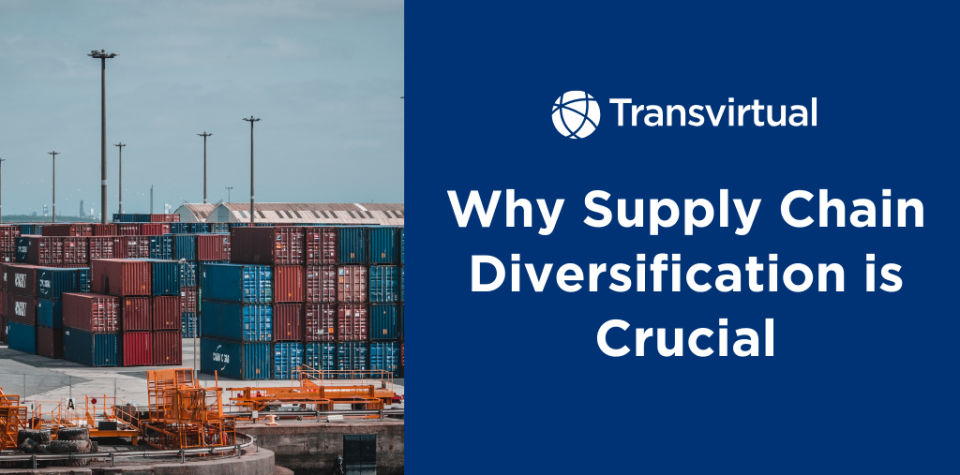Table of Contents
Supply chain diversification simply means not putting all your eggs in one basket. Instead of relying on a single supplier or region, you spread your sourcing across multiple options to reduce risk.
This has never been more important. Pandemics, geopolitical tensions, natural disasters, and sudden economic shifts have shown just how quickly global trade can be disrupted. According to a 2022 survey by Canadian Manufacturers and Exporters, 90% of Canadian manufacturers reported facing supply chain disruptions, with over 60% indicating these disruptions were major or severe.
Businesses that rely on a single source often find themselves at a disadvantage when things go wrong. If your business relies too heavily on a single source, you could be setting yourself up for bigger risks than you realize. Here are reasons why source and supply chain diversification is the way to go.
Reasons to Implement Supply Chain Diversification
Diversification helps meet specific business needs and ensures operational continuity, making your supply chain more adaptable and resilient. Learn more reasons why diversification is crucial for today’s businesses.
Minimize the impact of disruptions
Supply chain disruptions can strike from anywhere, be it natural disasters, global health crises, port strikes, or even a single supplier facing bankruptcy. In fact, a 2024 survey by the Canadian Chamber of Commerce found that two-thirds of Canadian businesses expect supply chain challenges to worsen over the next year, highlighting the urgent need for action. Among the causes for this is overreliance on the US market.
When your operations depend on just one link in the chain, that break can bring everything to a standstill. Diversification helps spread the risk, ensuring that no single disruption has the power to grind your business to a halt. A broader supplier base creates flexibility and keeps goods moving, even when challenges arise.
Safeguard against geopolitical risks
Geopolitical tensions like this can shift overnight, creating sudden challenges for global trade. Tariffs, sanctions, or border restrictions can instantly cut off access to critical suppliers, leaving businesses scrambling. Relying on a single market makes companies highly vulnerable to these shocks.
Diversifying sourcing across multiple regions ensures that if one door closes, others remain open. It’s important to explore alternative markets to reduce exposure to geopolitical issues and ever-changing policies.
Build resilience and adaptability
Building resilience and adaptability into your supply chain means preparing for the unexpected. When you depend too heavily on one source, you create a single point of failure. A port closure, factory shutdown, or raw material shortage in that location can stall your entire operation.
Tapping various suppliers gives your business the flexibility to pivot when issues arise. For example, if shipments are delayed from one region, you can switch to another source and keep transport in motion. Companies that expand and strengthen their sourcing domestically and internationally are better equipped to withstand shocks and global market shifts.
Engage in better supplier negotiations
Having multiple supplier options isn’t just about risk management. It’s also a powerful negotiation tool. If you only have one or a few suppliers, you’ll be at the mercy of their pricing, timelines, and terms. Diverse sources allow you to compare options, negotiate better deals, and secure more favorable contracts. It also prevents over-dependence on any one partner, reducing the risk that delays or price hikes disrupt your operations. A wide range of sourcing options also means you have better options and more product availability.
How to Develop a Supply Chain Diversification Strategy
Here are ways to start working on your diversification strategy and build a supply chain that’s more resilient, adaptable, and prepared for whatever challenges come next.
Evaluate your current suppliers
First, assess your current suppliers for reliability, financial stability, and overall risk exposure. Look at their track record, delivery times, and ability to scale when demand spikes. Identify areas where your business is over-dependent on a single supplier or region, as these create single points of failure. Understanding your existing network is the first step toward smarter diversification. Make informed decisions about where to add alternatives and reduce overall risk by understanding where your suppliers are strong and which are vulnerable.
Identify potential risks
Map out potential risks across your supply chain, including geopolitical issues, environmental threats, and logistical challenges. Don’t focus solely on cost. Consider long-term stability and reliability. For example, a low-cost supplier in a politically unstable region may seem attractive, but the risk of disruption could outweigh savings.
Plan mitigation strategies, such as sourcing from multiple regions or building safety stock. A proactive approach ensures that your supply chain is resilient, adaptable, and ready to handle unexpected challenges without compromising operations or customer commitments.
Use technology
Leverage technology to make your supply chain smarter and more transparent. Supply chain management software provides real-time visibility into supplier performance, inventory levels, and potential bottlenecks. Predictive analytics can forecast disruptions before they happen, helping you plan alternatives and reduce downtime. Transvirtual’s platform takes this a step further by offering route optimization, carrier tracking, and automated reporting, giving you a complete view of your freight operations.
Technology also improves communication with suppliers, ensuring faster responses to changes in demand or delays. Integrating digital tools into your strategy equips you to manage risks more effectively and make informed decisions that strengthen resilience, efficiency, and agility across your supply chain network.
Conduct Periodic Reviews
Regularly reviewing supplier performance is essential to maintaining a healthy and strong supply chain. Track delivery times, quality, pricing, and compliance metrics to identify potential issues early. Periodic assessments also allow you to spot over-dependence on certain suppliers or regions, giving you time to diversify before problems arise.
Staying proactive means adjusting sourcing strategies, renegotiating contracts, or onboarding new suppliers as needed more effectively. Routine reviews ensure that your supply chain remains agile and prepared for change, rather than reacting to crises.
Diversification: The Secret to a Stronger Supply Chain
Diversifying your supply chain is necessary. Every disruption avoided or delay mitigated strengthens your business’s ability to grow and compete. Begin with small steps: review your suppliers, assess risks, and leverage technology to stay ahead. Transvirtual’s Transportation Management System gives you the insight and control you need to make diversification actionable and easier to manage. Take control of your supply chain and start building resilience now.



